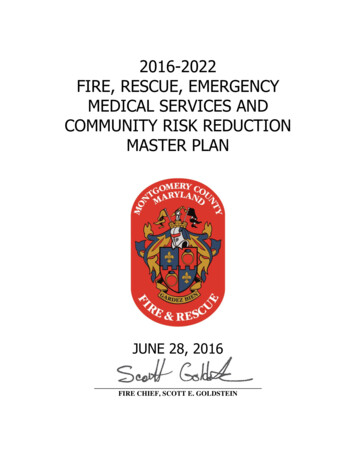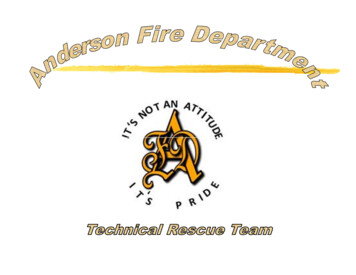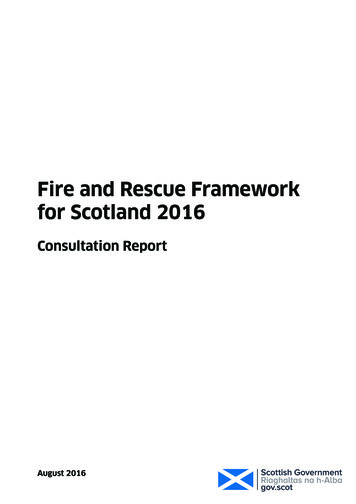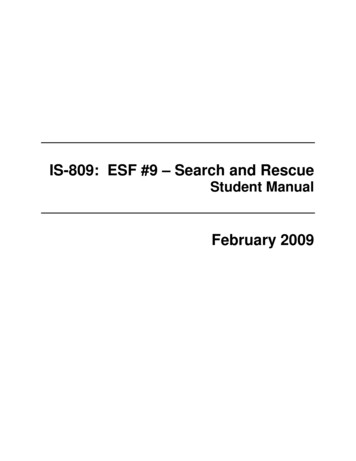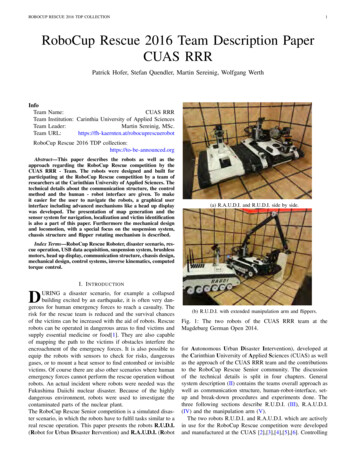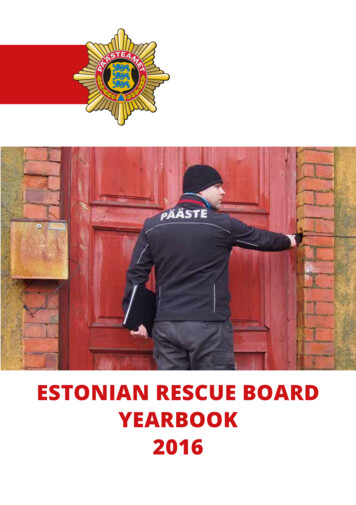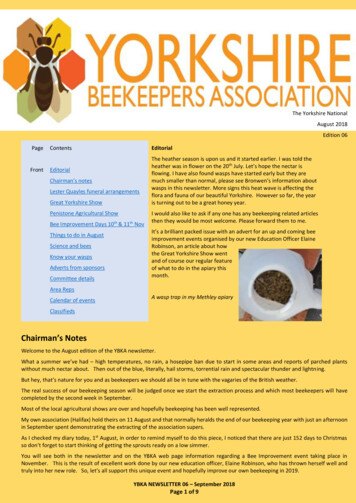
Transcription
SOUTH YORKSHIRE FIRE &RESCUEBUSINESS FIRE SAFETYPREMISES LOG BOOKResponsible person :Address :Date Issued :-BFSCS/TG/10/18-1-
Contents of Log BookTest & Maintenance GuidancePage NumberFire Alarm SystemsAutomatic Release Devices/Fixed SystemsFire ExtinguishersEmergency LightingHose ReelsStaff Training3- 456788-9Recording of Tests & MaintenanceRecord of Business Fire Safety or Fire Authority VisitBreakdown & Location of Call PointsFire Detection System Record of TestsRecord of False AlarmsAutomatic Door Release Mechanisms Record of TestsMonthly Fire Extinguisher ChecksMonthly Checks for Emergency LightingRecord of Hose Reel Maintenance ChecksRecord of Fire Evacuation DrillsExample of a Staff Training RecordExample of Daily ChecksSouth YorkshireFire & RescueFireExtinguisherContractorEscape LightingContractor1011121314151617181920Useful Telephone NumbersFire SafetyOfficerFire AlarmContractorBuilding &MaintenanceBritish StandardsThis Log Book has been issued by the Business Fire Safety Departmentof South Yorkshire Fire and Rescue. It must be noted that BritishStandards are issued, amended and withdrawn on a regular basis. TheStandards referred to in this document were current at the date ofpublication in October 2018.The Log Book identifies “Best Practice” for the Responsible Person1.(1) Responsible Person is as defined within the Regulatory Reform (Fire Safety) Order 2005BFSCS/TG/10/18-2-
Fire Alarm Detection System Checks and MaintenanceIt is important to ensure that any testing or work taking place on the fire alarmsystem does not result in a false signal or false alarm call being received bySouth Yorkshire Fire and Rescue (SYFR), which will result in a false alarmbeing registered against the premises.The Responsible Person should appoint a single named competent person tosupervise all matters pertaining to the fire alarm system and the maintenance of thelog book. Individual break glass call points should be listed on the attached table, onpage 12, by a number or letter and physical location.Daily: The main and repeater panels should be checked to confirm they are innormal operation and no faults have been automatically registered. Where faults arefound they are to be recorded and reported.* Weekly: A different manual break glass call point should be tested each week toensure premises rotation The test should be at the same day and time each week and should last nolonger than a minute Staff should be aware that they can feedback comments as part of the test,such as poor audibility levels The results of the test are to be logged Where employees work outside the test hours a further monthly test shouldtake place to ensure familiarity of the alarm for these staff Voice alarms should be tested in accordance with BS 5839-8 2013 orequivalentAny alarm receiving centre must be contacted before and after the test to ensureunwanted alarms are avoided and to check the signal was received at the receivingcentre.* Monthly: The following tests must be carried out by a competent and trainedperson: Where an automatically started emergency generator is part of the standbypower supply it should be started by a power failure simulation and run for 60minutes in accordance with the manufacturers instructions. Where batteries are the emergency supply a visual inspection of the batteriesand connections should be made.* Quarterly: All vented batteries and connections must be examined by a competentengineer and topped up as required.* Six Monthly:(Where the fire detection system has features that permit functions to beautomatically monitored and faults or warnings made available to an authorisedperson and when proven unnecessary by the equipment manufacturer, this testingcan be omitted.)Testing must be carried out by a competent and qualified person.If the testing is to be carried out it must be a full inspection, service and preventativemaintenance checks in accordance with BS 5839 – 1-2017.* Annual: As for “Six Monthly” but in compliance with BS 5839 – 1-2017.(*) Indicates that a record must be logged and recordedBFSCS/TG/10/18-3-
* Non Routine Attention & Maintenance: The listed areas below are periods whenthe fire alarm system requires non routine maintenance and inspection. All the listedareas require to be logged: Full inspection of an existing system when a new servicing organisation takesoverWhen there has been a repair to a fault or damage to the systemAfter modifications including system extensions, alterations or changes inoccupancy and false alarmsActions to address an unacceptable rate of false alarmsSystem inspection after a fireSystem inspection after a long period of disconnection*False Alarm Activations: False alarms and activations are to be recorded in thislog at page 13.BFSCS/TG/10/18-4-
Maintenance for Automatic Release Mechanisms for Doors and ShuttersDaily: Door hold open devices should be released daily.* Weekly: When the weekly test of the fire detection is carried out and all releasemechanisms activate this would normally meet the requirements of the standard test.However, if during normal working hours occupants may be placed at risk by the test,a safe method of carrying out the test must be found.One method of complying with the requirement is to provide prior warning of theimminent release of doors transmitted to occupants by means of public address or bya local audible warning device at each door.Alternatively, the interface between the fire detection system and alarm system to therelease mechanisms could be disabled at the time of the weekly fire test and afurther test carried out, at a time of low occupancy to test the release mechanisms.Where all mechanisms are not released during the weekly test a suitable test regimemust be developed to compensate,* Six Monthly and Annual Servicing: Full servicing and preventative maintenanceshould be carried out by a competent and qualified person in compliance with BS7273-4:2015 or equivalent standard.Fixed Fire Fighting InstallationsFixed fire fighting installations such as Water Sprinkler systems, Inert GasInstallations and Smoke Control equipment vary greatly in their design andapplications. As a result any planned servicing or maintenance must be carried outby the manufacturer’s recommendations for that installation as well as the relevantlegislation or standards. Any work should be carried out by a competent engineerfamiliar with the design, operations and application of the system and equipment.BFSCS/TG/10/18-5-
Maintenance and Checks for Fire Extinguishers* Monthly: The responsible person should carry out visual inspections of allextinguishers regularly, at periods of not less than a month and where necessarymore frequently i.e. premises open to the public: Confirm extinguishers are in designated locations Unobstructed and visible to users Instructions can be read Extinguishers have not been damaged or discharged Gauges are in the “operating” zone Seals have not been removed or broken.Corrective action must be taken where necessary.* Annual and other inspections:Work must be completed by a competent person2, normally a qualified engineer.There is a tolerance level of one month for practical purposes.Table of maintenance intervals:-Type ofExtinguisherBasicServiceWater, foam,foam basedAnnuallyPowderPowderprimary sealedAnnuallyAnnuallyCO2AnnuallyExtended Service andRecharging if necessaryOverhaul andRechargingEvery 5 years. The replacementof parts does not affect theseintervalsEvery 5 yearsEvery 10 years by return tomanufacturer if primary sealedpressure type.-------Every 10 YearsThe responsible person is to ensure that maintenance inspections are carried out bya competent person in accordance with the manufacturers, specifications and currentBritish Standards or equivalent.The fixed durable extinguisher maintenance label is to be fully completed for eachchecked extinguisher, using an indelible marker/pen.Where an extinguisher is recharged for any reason the date must be shown on themaintenance label.(All maintenance and testing must be in compliance with BS 5306-3:2017 orequivalent standards)(2) Competent Person is as defined within the Management of Health & Safety at Work Regulations 1999BFSCS/TG/10/18-6-
Maintenance and Checks for Emergency LightingThe responsible person should appoint a competent person to supervise the testingand maintenance of the system and logging of all details.Daily: The indicators of the central power supply should be visually inspected toconfirm all indicators are in a ready condition. This does not require an operationstest. Any faults are to be actioned and recorded.Weekly: If rechargeable LED torches form part of the emergency lighting systemthey are to be checked to ensure they are being charged and operate.* Monthly: If automatic testing devices are used the results of the short term durationtest shall be recorded, for all other systems: Energise each luminaire and illuminated exit sign by simulating afailure of supply for sufficient time to illuminate each lamp. Check all luminaire are clean, undamaged and operating correctly At the end of the test restore normal power and ensure indicator lightsare showing power has been restored. Central battery systems are to have their system monitors checked. Generators should be tested in accordance with the manufacturersinstructions by a competent person and the log book completed.Any faults or repairs are to be recorded.* Annual: Inspections and testing should be carried out by a competent engineer. Ifautomatic testing devices are used, the results of the full duration test shall berecorded. For all other systems the monthly test shall be carried out with the followingadditions: Luminaries and internally illuminated signs are to be tested for fullduration in accordance with manufacturer’s recommendations. On the resupply of normal lighting indicator lamps and chargingarrangements are to be checked for proper functioning. Generators are to be tested in accordance with the manufacturersinstructions by a competent person and the log book completedEmergency lighting continuedFull duration tests, wherever possible, are to be undertaken preceding a period of lowrisk and where required alternative suitable temporary arrangements are to be madeuntil the batteries have been recharged.Any faults or repair are to be recorded.(All maintenance and testing must be in compliance with BS EN 50172: 2004 andISO 8528 – 13 or equivalent standard)BFSCS/TG/10/18-7-
Maintenance and Checks for Hose ReelsRoutine and regular checks are to be carried out by the responsible person or hisrepresentative at suitable intervals, dependant upon the premises risk assessment,to ensure: Hose reels are located in their designated place They are unobstructed and signage and instructions are legible There are no obvious defects, corrosion or leaks.Any faults or repairs are to be recorded.*Annual: A full inspection must be carried out by a trained and competent person. Thehose reel must be fully run out and tested under operational pressure for any wear,damage or defects. Any faults or repair are to be recordedAt 5 year intervals all hoses should be pressurised to maximum working pressure bya competent person and a full maintenance inspection completed. This inspection isto be logged and the fixed maintenance label endorsed.The provision of additional fire safety precautions should be considered duringmaintenance periods or when water supplies are shut down.(All maintenance and testing must be in compliance with BS EN 671-3 2012 orequivalent standard)Staff Training & Evacuation TestsThe responsible person is to ensure that all members of staff are fully instructed andtrained. This is to ensure that they understand the fire alarm system, evacuation plans ofthe premises and the action to be taken in the event of a fire. This should normally becompleted and recorded as part of an induction process.An example of a Training Record is at Page 20.The evacuation guidance signage should match the evacuation plan and training for thepremises.A competent person should have overall responsibility for organising staff trainingfrom written instructions and must record the training data for each staff membertrained.The risk assessment and type of premises will determine how often staff will receiverefresher training after induction and the amount of fire evacuation drills carried out peryear, the minimum being one evacuation per year for all premises.A well planned and executed fire evacuation drill will confirm staff understanding oftraining. The responsible person should encourage staff feedback, which should berecorded, from lessons learned during any evacuation and amend the evacuation planand risk assessment where required.Training standards and the evacuation plan are to meet the requirements of theRegulatory Reform (Fire Safety) Order 2005Instruction and training should be created from the following list, dependant on the typeof premises and risk assessment, items 1- 10 refer to all premises:BFSCS/TG/10/18-8-
(Training continued)1. Action to be taken upon discovering a fire2. Action to be taken on hearing the fire alarm3. How to raise the alarm and where the call points/bell, internal alarm,telephone and panel are located4. Know the correct method of calling the fire service5. Location and safe use of fire fighting equipment6. Knowledge of all escape routes and the assembly point7. Appreciation of the importance of fire doors and the need to close alldoors during an evacuation8. How to operate emergency exit doors9. What to do when the fire service arrive10. The importance of general housekeeping in the premises11. Why premises lifts should not be used during an evacuation12. How to evacuate members of the public13. How to move elderly or infirm persons who may require assistancein an emergency14. Be trained and practiced in the type of evacuation used in thepremises if hazardous materials are involved in the work area15. How to stop machines and powered processes and isolate powersupplies in the event of a fireBFSCS/TG/10/18-9-
RECORD OF THE BUSINESS FIRE SAFETY OFFICER OR ANY FIREAUTHORITY VISITDateFire AuthorityOfficers NameBFSCS/TG/10/18OfficersSignature- 10 -Comments/Reason for visit
BREAKDOWN AND LOCATION OF BREAK GLASS CALL POINTSBreak Glass PointIDNo/Letter/ColourBFSCS/TG/10/18Location in premise/workplace- 11 -
FIRE DETECTION SYSTEM - RECORD OF TESTSDateFire AlarmCall OperatesPointIDY/NBFSCS/TG/10/18Remedial Action- 12 -Print NameSignature
FIRE DETECTION SYSTEM - RECORD OF FALSE ALARMSDateCallPointIDBFSCS/TG/10/18Reason for activationActionsInitials- 13 -
AUTOMATIC DOOR/SHUTTER RELEASE SCS/TG/10/18LocationRemedial action- 14 -NameSignature
FIRE EXTINGUISHERS – MONTHLYRECORD OF TESTS AND G/10/18Remedial Action- 15 -NameSignature
EMERGENCY LIGHTING - MONTHLYRECORD OF TESTS AND G/10/18Remedial Action- 16 -NameSignature
HOSE REELSRECORD OF TESTS AND G/10/18Remedial Action- 17 -NameSignature
RECORD OF FIRE EVACUATION TRAINING(Recommended number of evacuations per annum:DateBFSCS/TG/10/18TimeFeedback/Action Points- 18 -Name)Signature
EXAMPLE OF A STAFF TRAINING RECORDYour Company/Business/Employers nameStaff members full nameRoleINITIAL TRAININGINSTRUCTOR12345678DATEFire PreventionDiscussion of hazardous materials andprocessDiscussion of Fire Prevention in theworkplaceEvacuationWhat to do if alarm is heard or a fire isfoundRecognise Fire Alarm or EvacuationSignalAssigned Evacuation DutiesShown all evacuation routes andassembly areaFire SafetyDiscussed any Emergency DutiesAware of location and operation of firefighting equipmentSigned by employee CommentsDate .REFRESHER re Training Courses and QualificationsDateCourse TitleAttendedCOMMENTSQualificationThis is purely an example based on best practice for you to produce your own format.The training record should reflect the specific training provided to your staff tomanage the fire safety risks in the workplace as an employer/responsible person.BFSCS/TG/10/18- 19 -
A Daily Check GuideThe daily check guide below is not comprehensive and there may be additional areas thatyou feel the need to check daily, as part of your fire safety measures. The guide shouldsupport your fire safety risk assessment and policy. The tasks need not be recorded but canbe seen as part of the daily routine but if records are maintained they would be seen as bestpractice by fire authorities and insurance companies.Daily ChecksYesEscape Routes Can all fire doors be opened immediately andeasily?Are fire doors clear of obstructions?No fire doors are wedged open?Are the escape routes sterile?Fire Warning System Is the panel showing “normal”?Are there any faults to be reported?Are other warning methods ready for use?Escape Lighting Are all luminaires and exit signs in workingcondition and undamaged?Are any signs damaged or faulty?Fire Fighting Equipment Are all fire extinguishers in the right place?Are they visible?Return those used as door wedges to the correctlocation?Other daily matters deemed necessary:BFSCS/TG/10/18- 20 -No
BUSINESS FIRE SAFETY PREMISES LOG BOOK Responsible person :- Address :- Date Issued :- BFSCS/TG/10/18 - 2 - Contents of Log Book Test & Maintenance Guidance Page Number Fire Alarm Systems 3- 4 Automatic Release Devices/Fixed Systems 5 Fire Extinguishers 6 Emergency Lighting 7 Hose Reels 8 .

